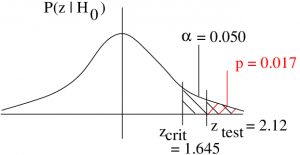9. Hypothesis Testing
9.4 z-Test for Proportions
The possible hypothesis pairs are :
| Two-tailed Test | Right-tailed Test | Left-tailed Test |
The steps in hypothesis testing for proportions are the same as hypothesis testing for means. Even the generic test statistic formula is the similar :
![]()
but now the observed and expected values are proportions, ![]() and
and ![]() respectively. The standard error in this case is
respectively. The standard error in this case is
![]()
Using this information with the generic form, which mimics a ![]() test statistic, the proportions test statistic is
test statistic, the proportions test statistic is
![Rendered by QuickLaTeX.com \[z_{test} = \frac{\hat{p}-p}{ \sqrt{\frac{pq}{n}}}\]](https://openpress.usask.ca/app/uploads/quicklatex/quicklatex.com-34f64be8d9b9597bc45fb06d40dea599_l3.png)
where ![]() is the number
is the number ![]() which appears in the
which appears in the ![]() hypothesis statement (see table above). This test statistic is valid only if
hypothesis statement (see table above). This test statistic is valid only if ![]() and
and ![]() (so that the normal distribution provides a good approximation for the relevant binomial distribution). But, even though the test statistic can be moulded into the generic form, the proportions test statistic comes from the sampling theory given by the binomial distributions and not from any distribution that has a standard error {\em per se}. The normal distribution with
(so that the normal distribution provides a good approximation for the relevant binomial distribution). But, even though the test statistic can be moulded into the generic form, the proportions test statistic comes from the sampling theory given by the binomial distributions and not from any distribution that has a standard error {\em per se}. The normal distribution with ![]() and
and ![]() (remember those binomial distribution formulae?)
(remember those binomial distribution formulae?) ![]() -transformed to a
-transformed to a ![]() -distribution with mean 0 and standard deviation 1 gives the test statistic formula. See the discussion in Section 8.4.
-distribution with mean 0 and standard deviation 1 gives the test statistic formula. See the discussion in Section 8.4.
Example 9.5 : An attorney claims that more than 25![]() of all lawyers advertise. A sample of 200 lawyers in a certain city showed that 63 had used some form of advertising. At
of all lawyers advertise. A sample of 200 lawyers in a certain city showed that 63 had used some form of advertising. At ![]() , is there enough evidence to support the attorney’s claim?
, is there enough evidence to support the attorney’s claim?
Solution :
1. Hypotheses.
![]() ,
, ![]() (claim)
(claim)
2. Critical statistic.
Using the t Distribution Table (last line) for a one tailed test at ![]() we find
we find ![]()
3. Test statistic.
![Rendered by QuickLaTeX.com \[z_{\rm test} = \frac{\hat{p} - p}{\sqrt{\frac{pq}{n}}}\]](https://openpress.usask.ca/app/uploads/quicklatex/quicklatex.com-3ba0ece5fa0323490001c0fbc55cdcdf_l3.png)
So using
![]()
![]()
find
![Rendered by QuickLaTeX.com \[z_{\rm test} = \frac{0.35 - 0.25}{\sqrt{\frac{(0.25)(0.75)}{200}}} = 2.12.\]](https://openpress.usask.ca/app/uploads/quicklatex/quicklatex.com-04c9085c10efcca11bafa9e08a3622f9_l3.png)
We can also find the ![]() value along with the critical statistic. (See the picture for the next step.) Use the Standard Normal Distribution Table to find
value along with the critical statistic. (See the picture for the next step.) Use the Standard Normal Distribution Table to find

4. Decision.
Refer to the diagram in Figure 9.4. It shows ![]() in the rejection region. So we reject
in the rejection region. So we reject ![]() .
.

We come, of course, to the same decision by considering the ![]() -value :
-value :
![]()
5. Interpretation.
There is enough evidence, using a ![]() -test at
-test at ![]() , to support the claim that more than
, to support the claim that more than ![]() of the lawyers use some form of advertising.
of the lawyers use some form of advertising.
▢

